I am Groot.
—
UPDATED 5/1/17: Guardians of the Galaxy Vol. 2 is out this week! Time to revisit this terrific piece by John DiBello, first published when the original GOTG arrived in theaters. It’s as timely now as it was then.
—
—
By JOHN DiBELLO
Right now in movie theaters, audiences are wowing to the most wooden performance even seen in a major motion picture — yes, more wooden than Disney’s Pinocchio! It’s the character who’s been constantly growing even though he’s still a bit green — Groot of Guardians of the Galaxy! But how did this giant herbaceous warrior sprout? Where’d he grow from? In short, wooden you like to know the origin of Groot?
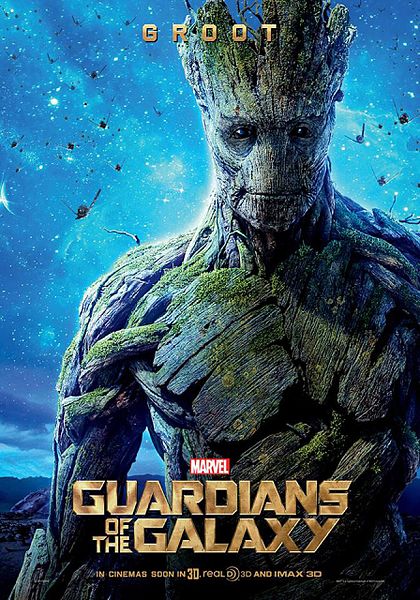
Let’s step back to the age of grand monsters from alien worlds attacking our civilization in short but terrifying comic book stories. This is the Atlas Age (named after Martin Goldman’s newsstand distribution and publishing company) of comics Journey into Mystery, Tales to Astonish, Strange Tales, and Amazing Adult Fantasy, all populated by weird aliens and macabre beasts. This is where we’ll find the seed of Groot’s origins:
1. Groot the Brute of Ill Repute
A large number of pre-Marvel, Timely- and Atlas-era characters were eventually integrated into the Marvel Universe: not only the grand triad of Captain America, the Sub-Mariner and the (original) Human Torch, but also Western stars Two-Gun Kid and the Rawhide Kid, teen idols Millie the Model and Patsy Walker — even Irving Forbush pre-dated the Fantastic Four. Great Atlas monsters were also retconned to be major players in Earth-616’s history: Fin Fang Foom, Xemnu the Titan, Goom (and his son Googam), and Spragg the Living Hill. All of these monsters are branches on Groot’s family tree.
Groot himself first appeared in 1960’s Tales to Astonish #13. The story follows the tried-and-true formula of the Atlas monster shorts: Hideous creature (often in giant underpants) attacks humanity and cannot be stopped, until a brilliant scientist/everyday Joe manages to outwit monster or discovers its glaringly huge Achilles heel. These tales capitalized, with great effectiveness, upon the terror of alien invasions in 1950s popular culture, with a distinct nod of the snazzy snap-brimmed hat to Cold War fears of the Russians invading or destroying America.
Groot’s debut follows the usual trope of ordinary people having a Close Encounter of the First Kind, an occurrence more frequent during the Atlas Age than high school sock hops. Lucky they taught all those kids to duck and cover when monsters attack.
In fact, those tropes are so iconic that John Byrne mirrored them — exceptionally closely — in his Fantastic Four comic homaging Marvel’s early Age of Monsters:
The giant alien who emerges from the glowing spacecraft is not only made of wood, he can assimilate it to grow larger and more powerful. He sucks up lumber, barrels, fences, ventriloquist dummies, pirate peglegs, those little golf tee-jumping games you get on the table at Cracker Barrel restaurants!!
Why, that alien even stole Snoopy’s doghouse!
Talking Giant Tree Guy is revealed as Groot, monarch of Planet X, conveniently located in the galaxy between Planets W and Y. I’m wondering how poor this king’s approval ratings must have been for his people to send him off conquering the galaxy all by his lonesome instead of sending an entire forest of tree-soldiers. I’d like to imagine that in his absence, Groot’s planet developed a system of one tree/one vote and evolved quickly into a fair and democratic woodocracy.
Groot’s ultimate plans include scooping entire cities out of the Earth and then flying them away into space to become part of the great Wooden Empire. Say! He’s just like the Borg! If they were made of wood.
Since he’s “Master of All Wood,” Groot can command the trees of the world to attack the humans. To be honest, though, this kind of serves us right for the lumber industry, Christmas tree farming, and carving our initials in hearts into the bark of our new leafy overlords. Time for humanity to migrate to the desert, I guess!
Until, just as H.G. Wells’s Martians were felled by tiny microscopic germs, Leslie Evans (remember him from the first panel?) defeats Groot with termites, “the deadliest enemy of wood.” Or is the deadliest enemy of wood…man?
—
2. Other Branches of Groot’s Family Tree
The monster Groot, clever though the idea may be, isn’t entirely original. Intelligent trees have existed in popular mythology and fiction from Muhammad’s Weeping Tree to the early Christian poem Dream of the Rood, through L. Frank Baum’s Oz novels and Hugh Lofting’s brilliantly spooky 1928 novel “Doctor Dolittle in the Moon.” Walt Disney’s 1932 short cartoon “Flowers and Trees” featured woods that not only walked but danced:
Alan Scott’s magic ring didn’t work on wood, making a tree — a spanking tree at that — a tricky foe for the Golden Age Green Lantern:
Writers Stan Lee and Larry Lieber were likely to re-use names and ideas in their large inventory of monster tales. Is Emperor Groot of Pluto any relation to Groot, Monarch of Planet X? Marvel trivia buffs have probably tried to define a familial connection between the two, but it’s much more certain that Lieber forgot the name had been used previously.
What about that generic-brand-named Planet X? Is it the same world that gave birth to monster Goom? It certainly appears so — after all, trees are Goom’s natural-born enemy!
Trees with human characteristics are such a popular trope that they even appear a year after Groot, in the origin of the DC’s Justice League of America.
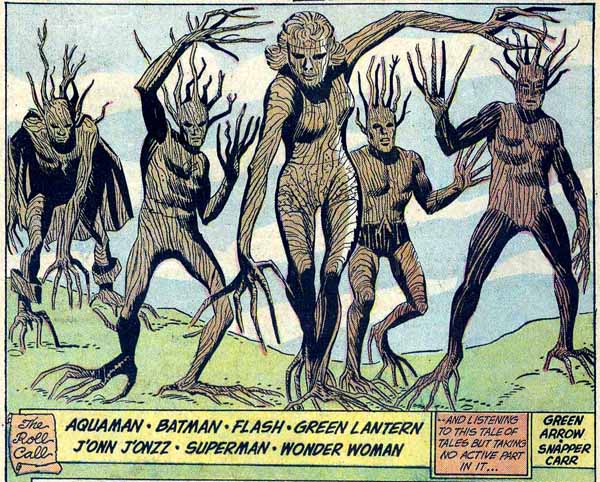
Panel from Justice League of America #9 (1962), script by Gardner Fox, pencils by Mike Sekowsky and Bernard Sachs
But it’s probably going way too far out on a branch to claim any connection to this gangster from a 1949 DC comic.
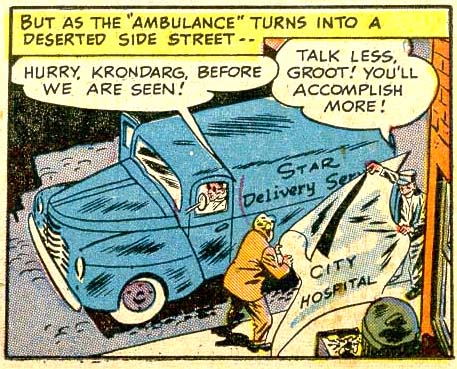
Panel from “The Dead Man’s Chest” in Sensation Comics #85 (1949), script by Robert Kanigher, art by Bob Oksner and Bernard Sachs
—
3. Groot Attacks! Again!
Despite being termite-ridden and used to heat our homes during the long cold winter of ’61, Groot made a good name for himself, thanks to his wood-savvy Hollywood publicist. Pre-teen Peter Parker, Atlas monster comics fanatic, dreams that he and Uncle Ben encounter Groot on a fishing trip in a story set before Amazing Fantasy #15 and that fateful, iconic spider bite. One step in the wrong direction on this trip and Peter might have become the Amazing Termite-Man. He does whatever a termite can, which is eat trees so J. Jonah Jameson can’t get wood pulp paper on which to print the Daily Bugle.
Groot’s first “real-world” reappearance, however, is in another flashback comic set in the early days of the Marvel Age. Hey, how’d Groot get here? According to this tale, the Collector gathered all the Atlas-era monsters and stored them in caverns beneath Canada, until they were released by the Mole Man. Huh. Really? … Well, that’ll happen.
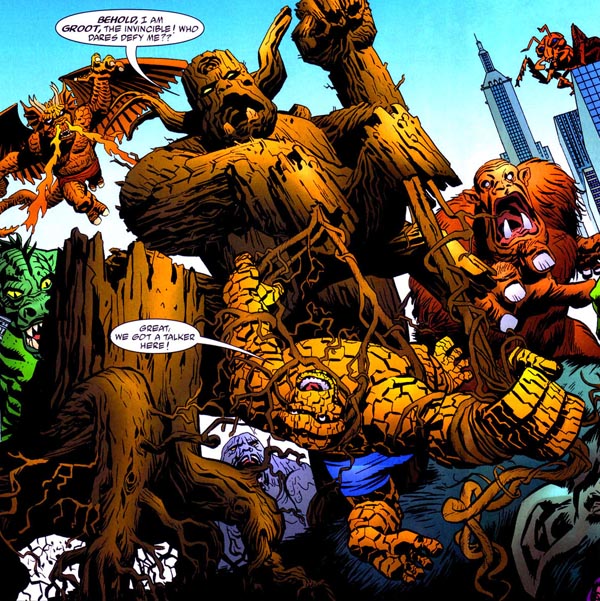
Marvel Monsters: Monsters on the Prowl one-shot (2005), script by Steve Niles, art by Duncan Fegredo
Both these stories featured Groot in continuity implant retcons, but his chronological next published appearance following his Tales to Astonish debut was in Hulk Annual #5… well, sort of. This isn’t the real Groot, but an incredible simulation created by Hulk adversary Xemnu the Titan — himself an Atlas monster from Journey into Mystery who was originally called…The Hulk! More proof that when Stan Lee found a good name, he’d keep using it.
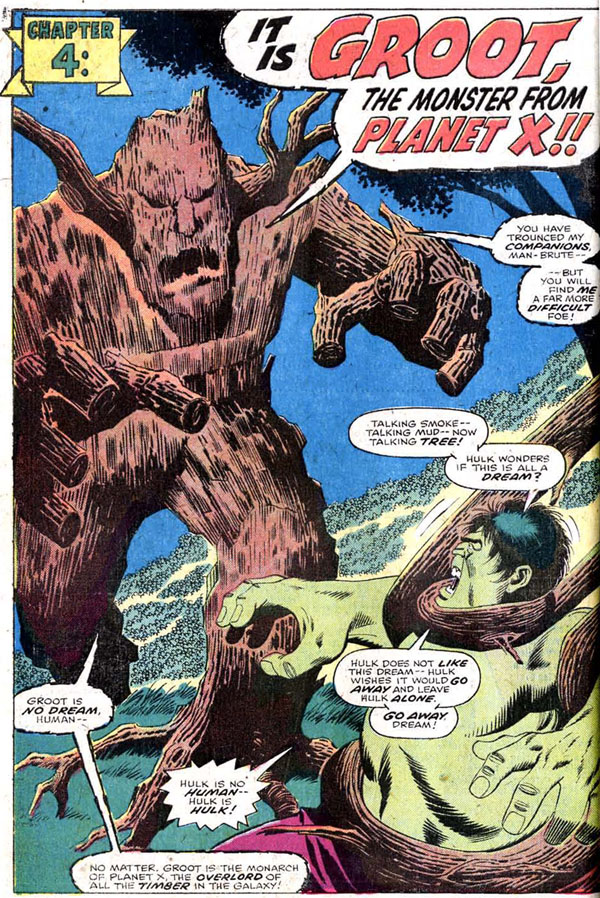
Panel from The Incredible Hulk Annual #5 (1976), script by Chris Claremont and Len Wein, art by Sal Buscema and Jack Abel
How does the Incredible Hulk defeat a giant walking tree? Pretty easily, as it turns out. HULK SMASH WOOD! is not exactly a fair battle. Too bad Bruce Banner hadn’t been the local scientist when the original Groot invaded.
Real Groot shows up again in Marvel’s Age of Throw-Anything-Against-the-Wall -and-See-If-It-Sticks (aka the ’90s), against a team of mystic and magic heroes called The Supernaturals. They really ought to reboot that book and name it Avengers Dark, dontcha think?
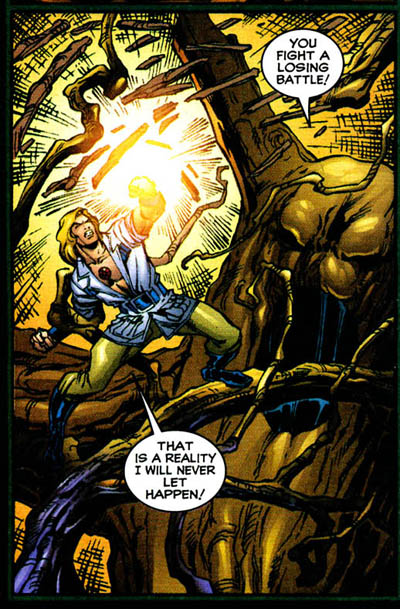
The Supernaturals #4 (1998), script by Brian Pulido and Marc Andreyko, art by Ivan Reis and Joe Pimental
The Monster Whose Bark is Almost As Bad As His Bite re-appeared in the 21st Century, first as an enemy to another good-deed doin’ squad of monsters…
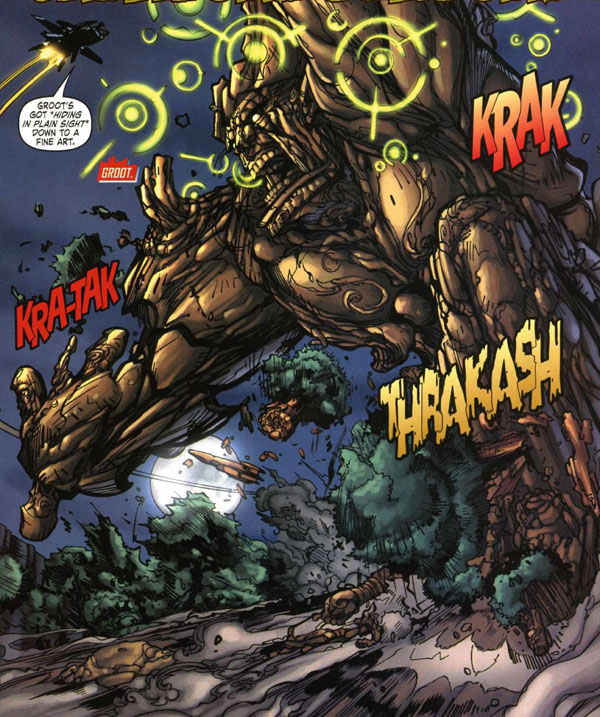
Panel from Nick Fury’s Howling Commandos #2 (2006), script by Keith Giffen, art by Eduardo Francisco and Robert Campanella
…and then joins as a member of that team. Which only goes to prove: like Magneto, Sandman or Doctor Octopus, there’s no villain Marvel won’t try to transform into a good guy.
But wait, wait, wait. Is this guy really Groot of the Guardians of the Galaxy? Well…yes and no. Yes in that he’s named Groot and he’s a tree person and he comes from Planet X… and no in that Groot is the name of all its tree creatures! Let’s backtrack in time a bit and see what’s a-happenin’ on Planet X, which we can only hope the X-Men’s lawyers don’t know about and sue for copyright infringement.
—
4. Let’s Take an Alternate Groot Home
Here’s a short, National Geographic-anthropology style summary of the culture and flora/fauna (flauna?) of Planet X: A hive mind of the forests of their world, the Groots have all evolved into separate woody beings with distinct personalities and quirks. Here’s our young Groot becoming angry and violent when another young Groot torments and tortures one of Planet X’s mammalian sentient beings. Also pictured: Groot, Groot and Groot.
For attacking another Groot, Groot is sentenced to exile from Planet X. I’d say good riddance, but it’s clear that he’s going to miss the green, green, trees of home.
Out in the vastness of Universe-616 (the one where Earth is the most important place in the galaxy), this Groot is held prisoner by the Kree. During this time he adopts the identity of Groot (Monarch of Planet X), much like the way you or I would put on a new cool persona at college to get over our embarrassment at being called a silly name (say, “Groot Boy“) in high school.

Page from Annihilation: Conquest—Starlord #1 (2007), script by Keith Giffen, art by Timothy Green II and Victor Olazaba
Joining Star-Lord’s newly formed and much more commercial “Hey kids let’s make a movie franchise” reboot version of the Guardians of the Galaxy, Groot befriends and teams with Rocket Raccoon, who is a raccoon with a machine gun, because, hey, his co-creators Bill Mantlo and Keith Giffen are comics gods and I will hear no harsh words against them.
Groot even gets a nifty new zoot-suit (or is that Groot-suit?) to match the rest of the Guardians, a team which during its relatively short publication life has counted among its members, Deathcry (the member of the Avengers no one likes to talk about), Bug from the Micronauts (both pictured below), not to mention Captain Mar-Vell’s sister Phyla-Vell, Moondragon, Mantis, a talking dog named Cosmo, and Vance Astrovik and Starhawk of the original Guardians. Most recently there’s been Iron Man, Venom, Carol Danvers — and I’m pretty sure Wolverine must have been a member at one time or another, because that’s the law at Marvel.
During this period of his adventures, Guardian Groot acts and speaks as though he were King Groot, and everyone is too polite to point out to him he’s pretty much cribbing his dialogue from Doctor Doom.
Like the Beatles, the Guardians split up following the cosmic events of Annihilation, War of Kings and all those outer space crossover events that were happening while Earth was fighting Civil War and Secret Invasion, or, in the case of the Beatles, after their famous rooftop concert. Rocket Raccoon journeys to Planet X and discovers that not only was his Groot not the king, but that his Groot has been placed under arrest and jailed for impersonating the monarch. To carry the Doctor Doom analogy another step further, this is like von Doom returning to Latveria to discover one of his Doom-Bots let Wolverine strike a match on its armor, so Doom destroys the Doom-Bot. But — bwah-ha-ha! — who would let that happen in a real comic book, huh?
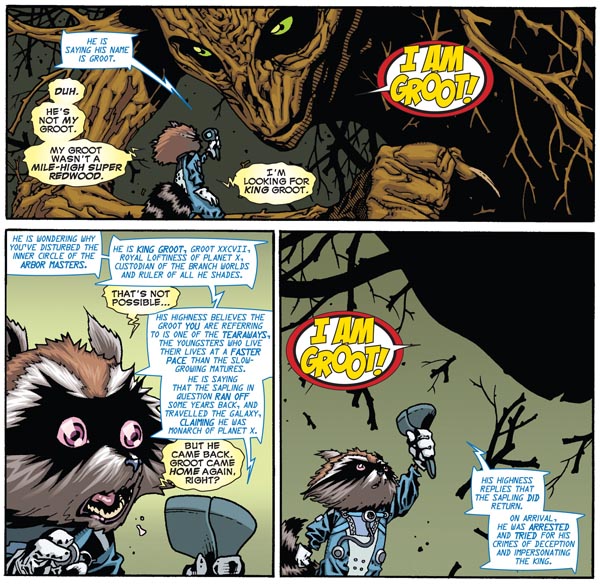
Panels from “Timely, Inc.” in Annihilators #1 (2011), script by Dan Abnett and Andy Lanning, art by Timothy Green
You know what happens next: raccoon outrage, dangerous rescue, heartfelt reunion, Groot hug.
Thus are the Guardians of the Galaxy reunited and reborn. A movie franchise is saved! Here Groot and Rocket go into sheer edge-of-your-seat adrenaline action, teaming up with Robert Downey Jr., Mark Ruffalo and Chris Hemsworth to battle Barbra Streisand’s stepson.
No longer impersonating his monarch, in the movie Groot now speaks in a familiar trio of monosyllabic words voiced by Vin Diesel, voted the Man Most Likely in Hollywood to Succeed as an Action Hero Solely Because of His Name. Let’s not forget that in addition to action movie roles in the Riddick and The Fast and Furious franchises, he also voiced one of the greatest characters in modern movie animation, The Iron Giant — so I’m completely confident in him garnering an Oscar nomination for his voice work as Groot. Especially since those three little words can just say so much.
Now you know everything you need to know about the universe’s mightiest wooden superhero, the only Marvel character whose age you can determine by chopping him in half and counting the rings. Any final words, big guy?

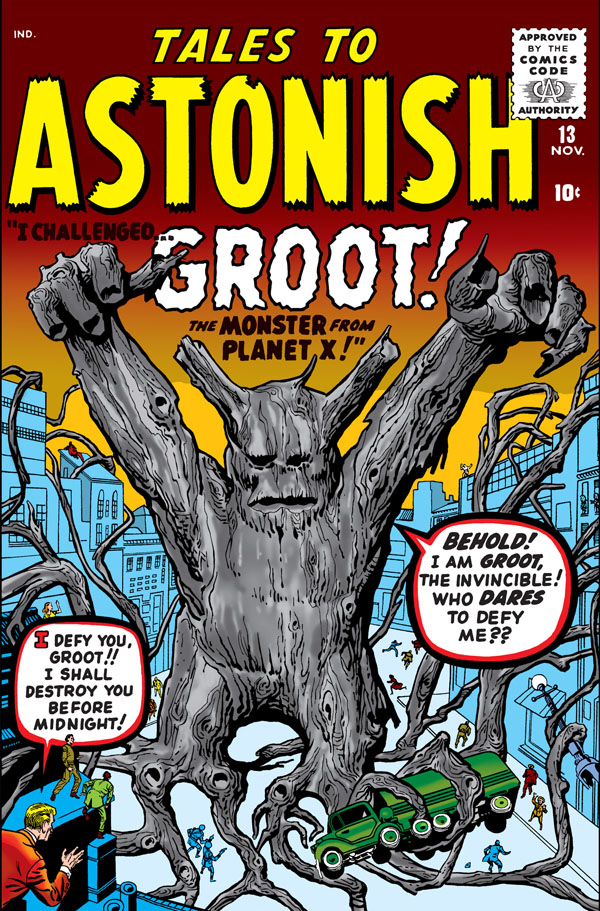
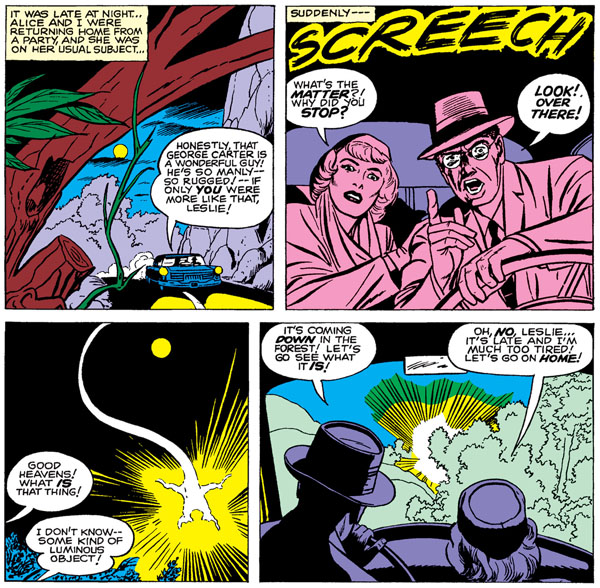
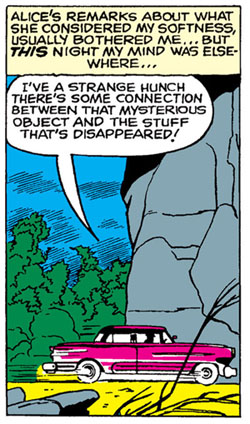
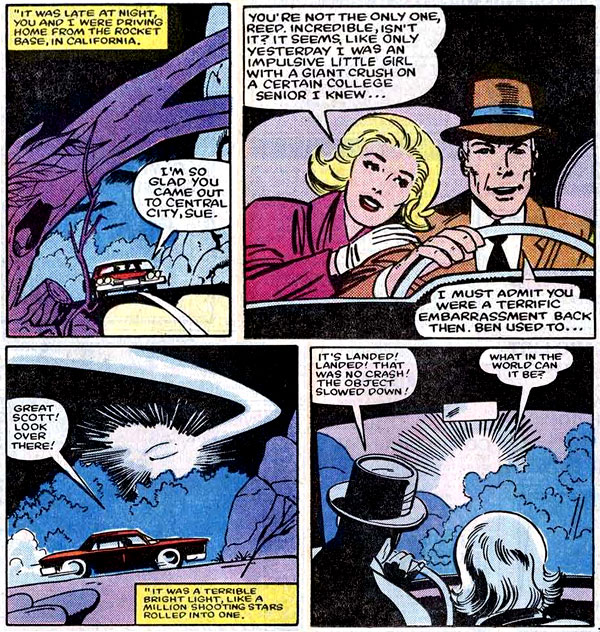
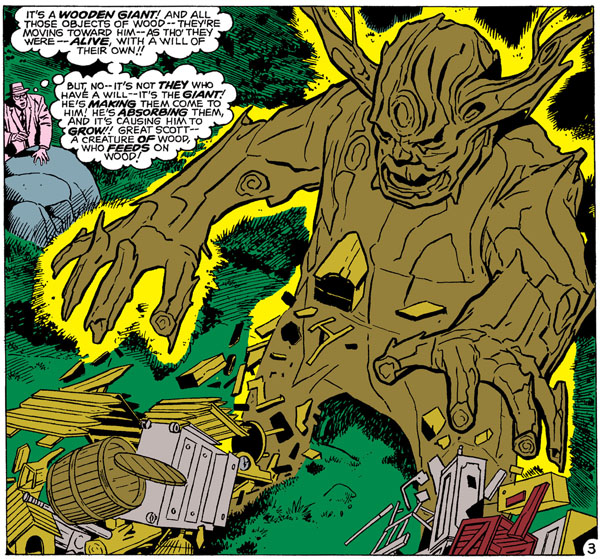
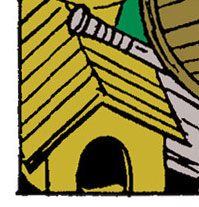
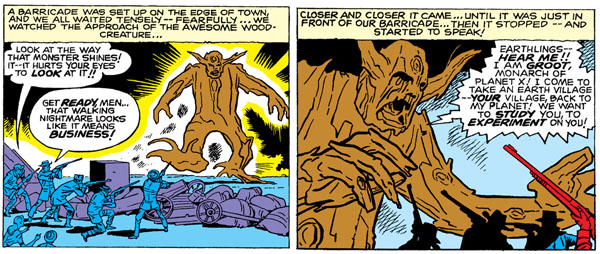
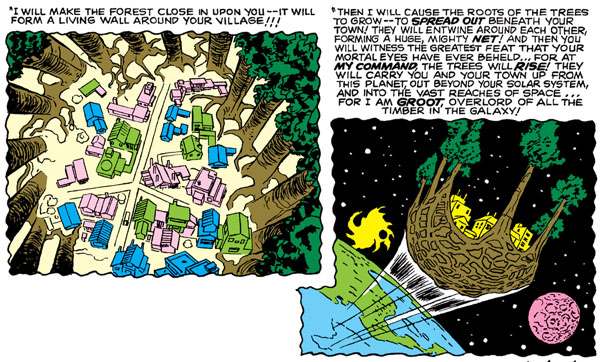
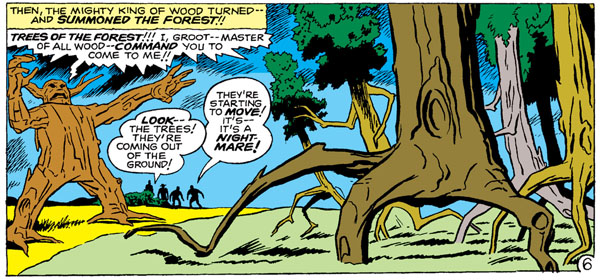
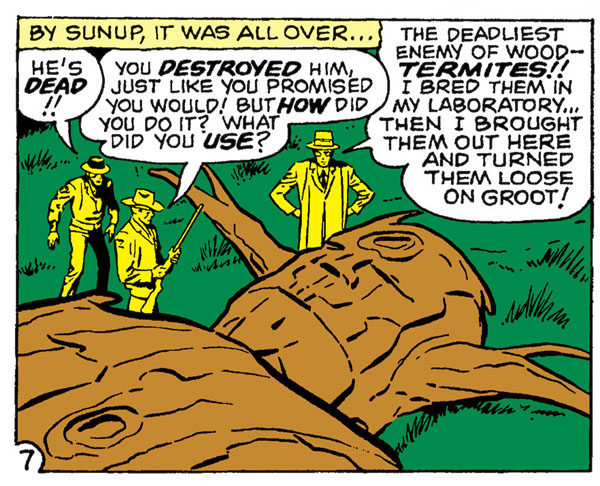

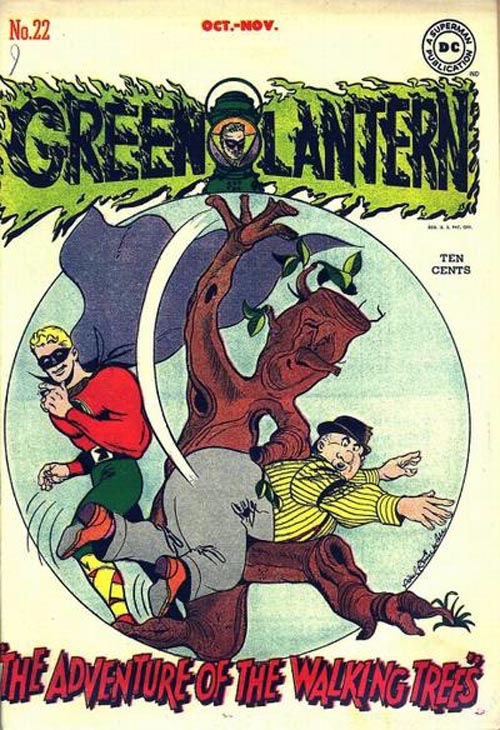
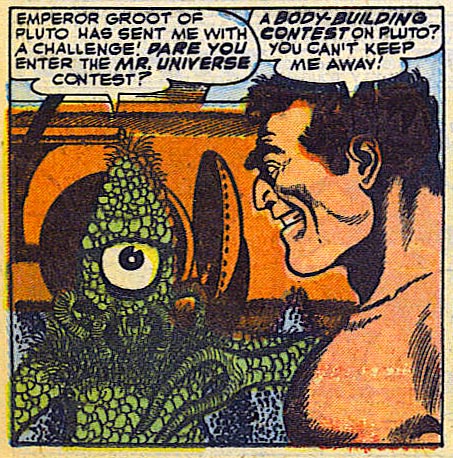
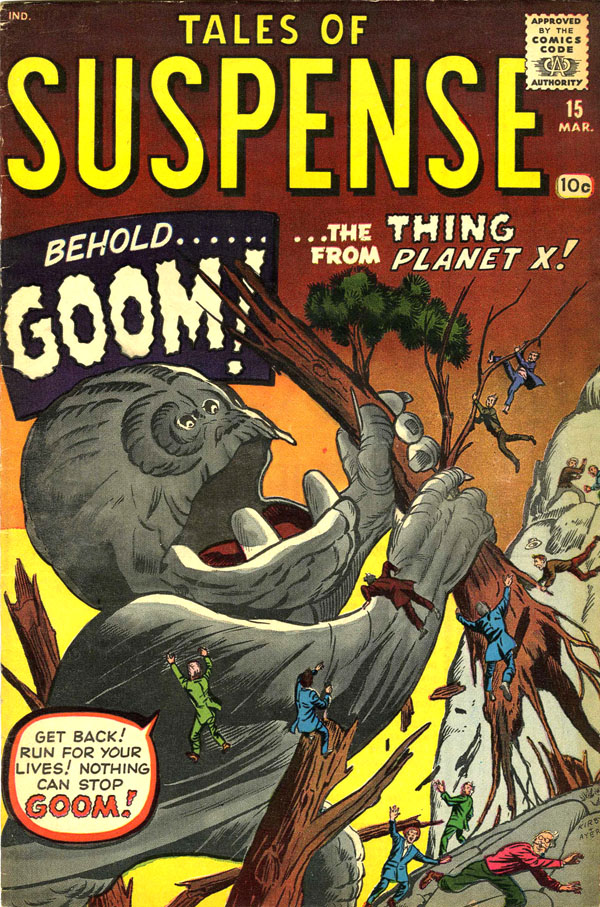
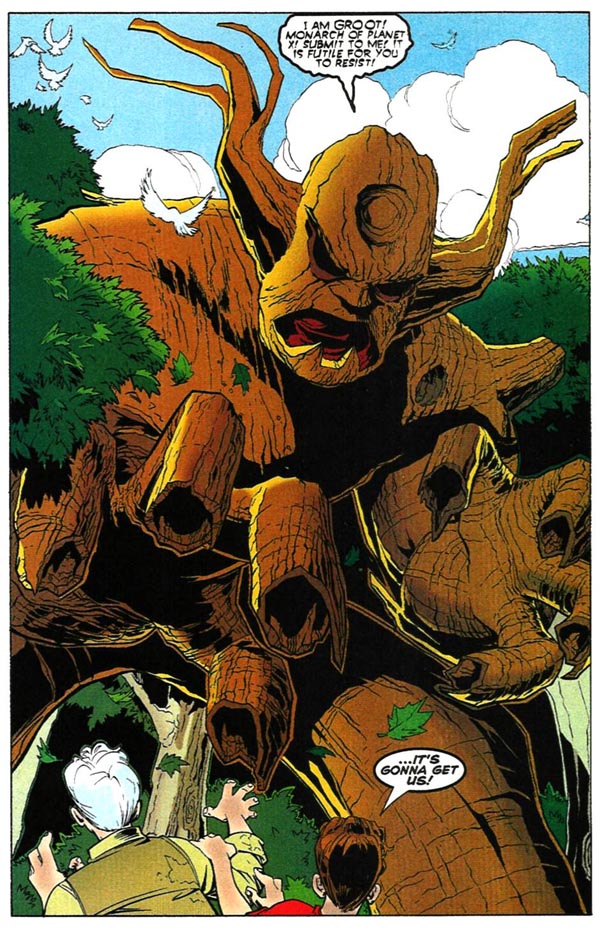
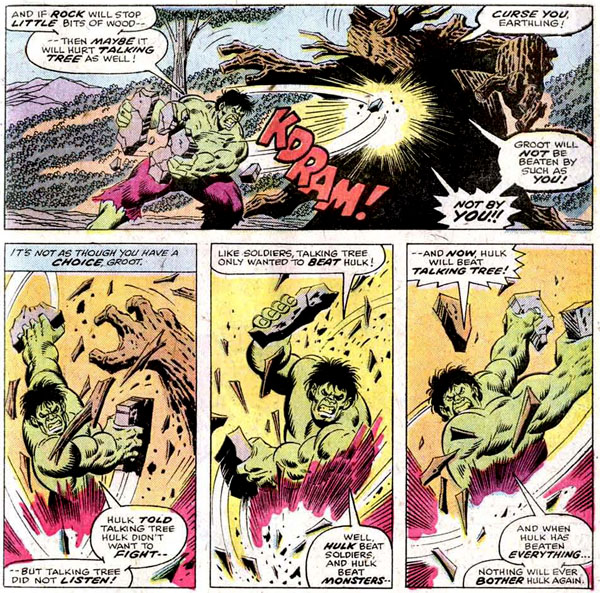
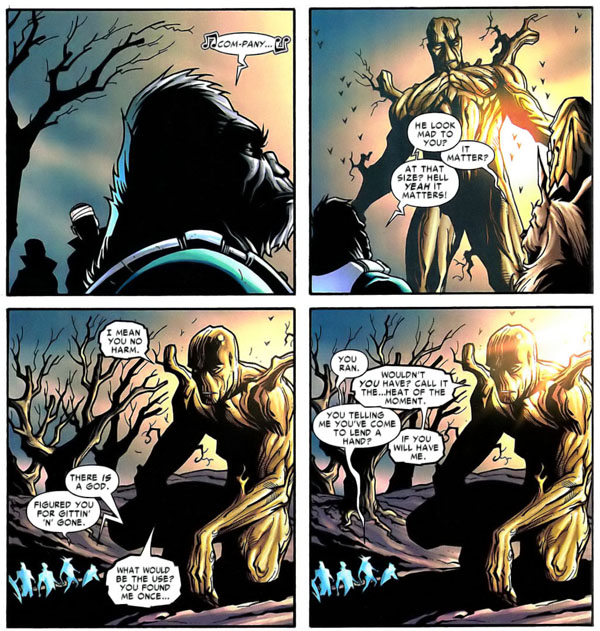
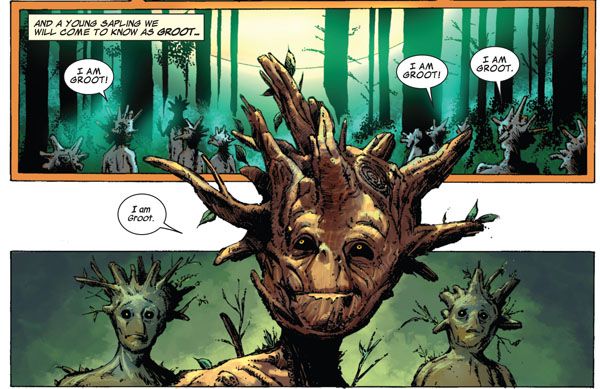
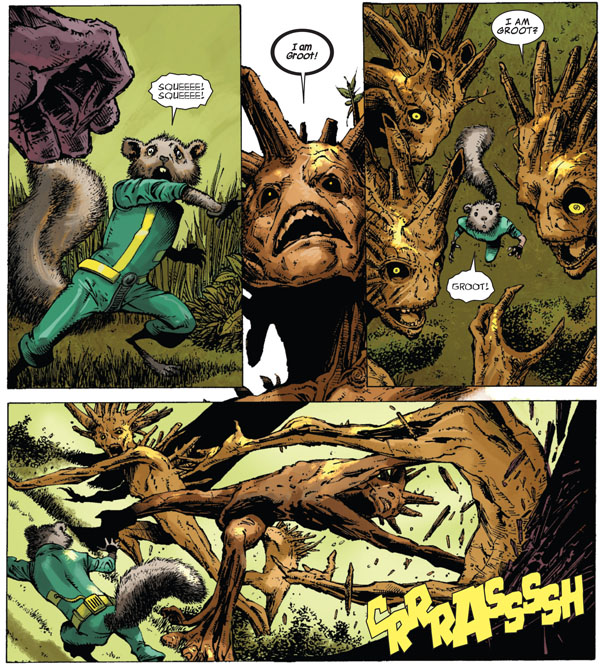
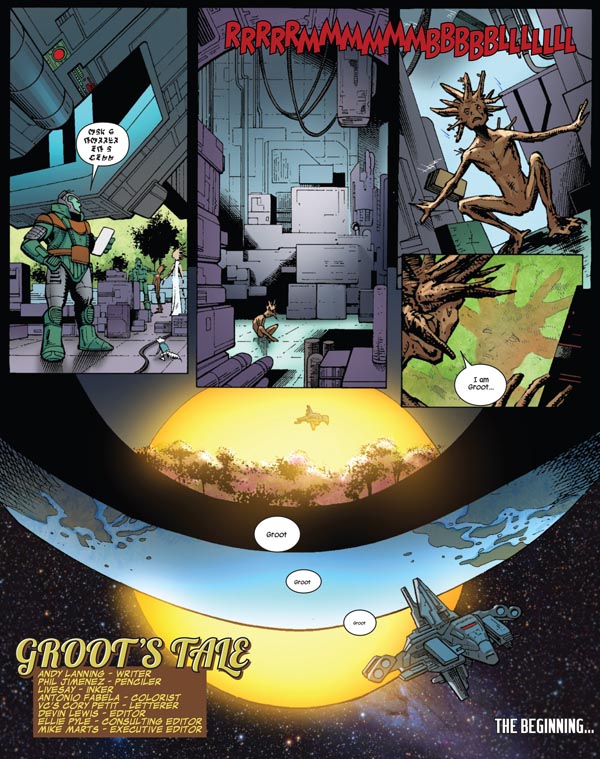
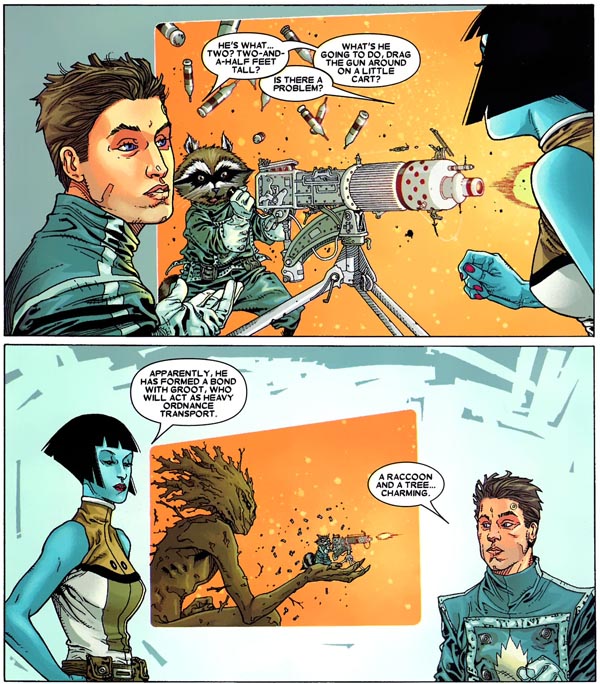
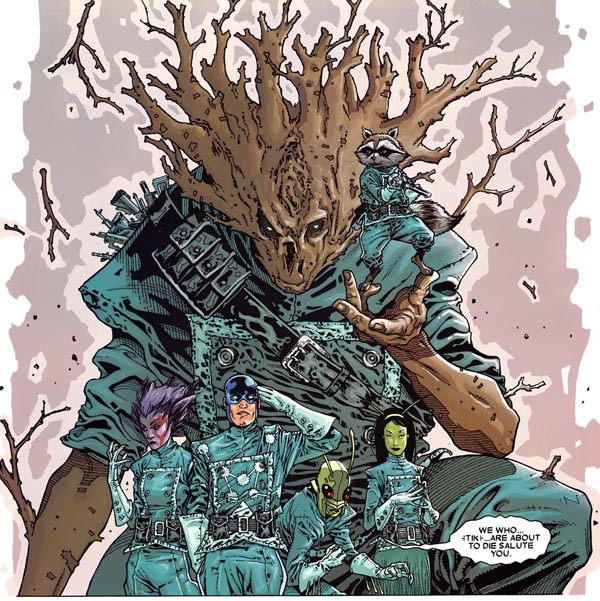

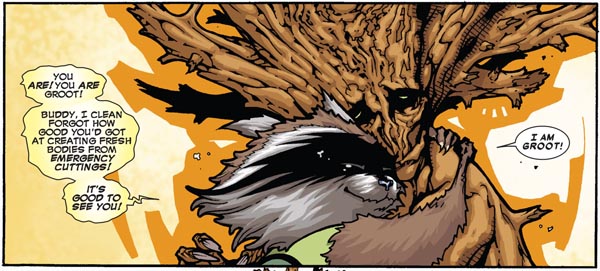
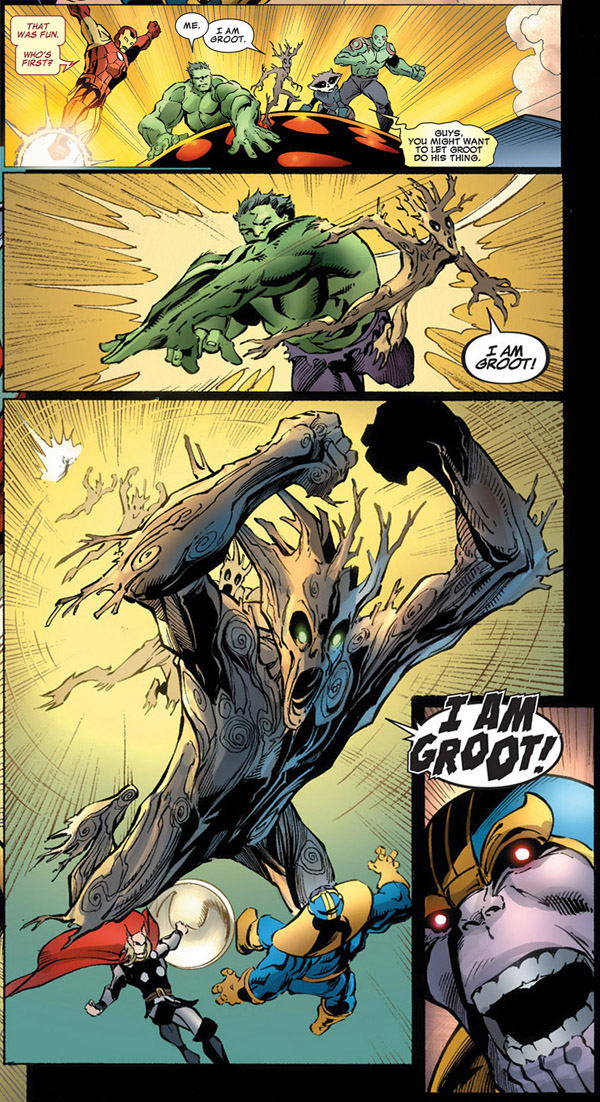
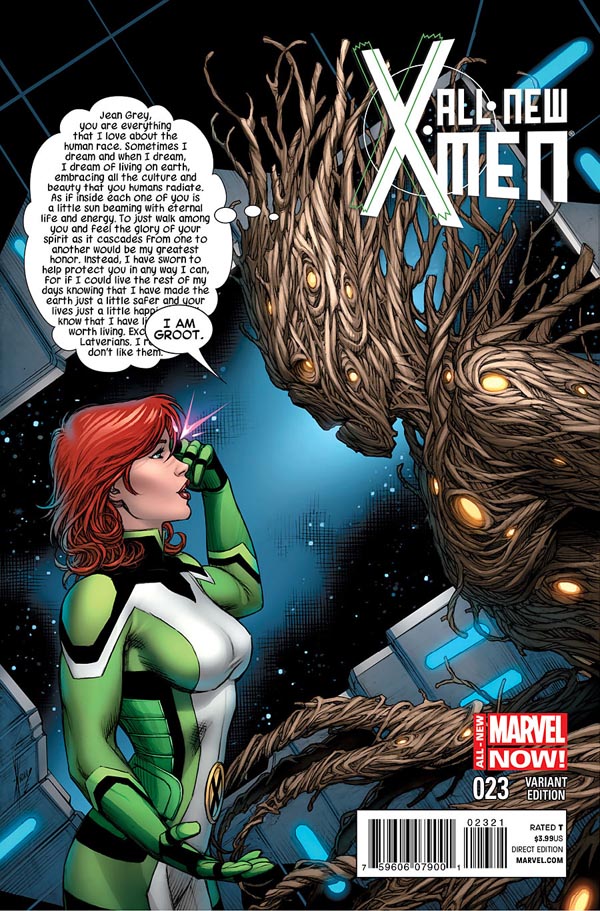
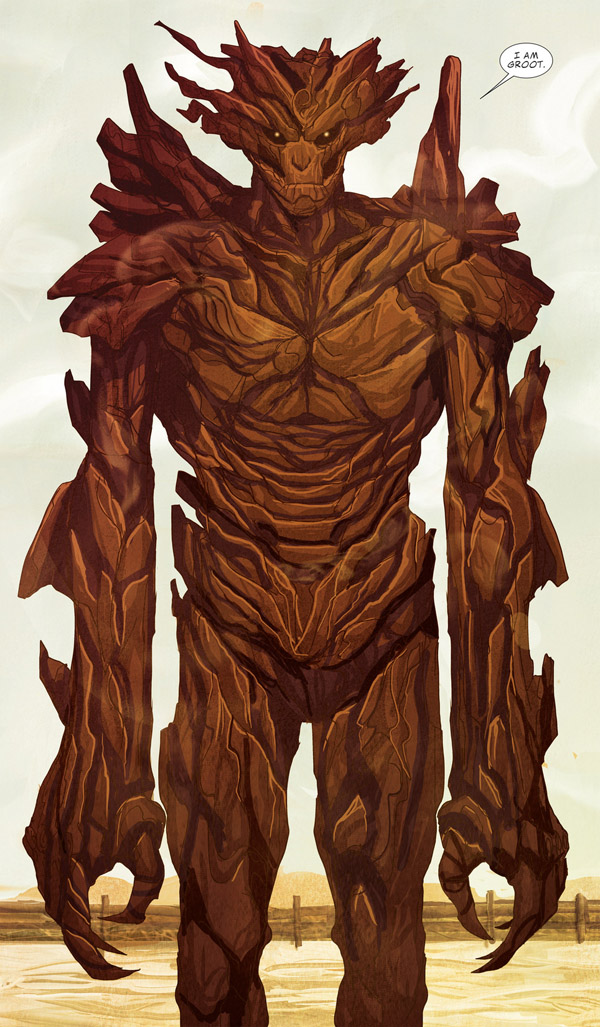
August 5, 2014
I’m a sap for comics history, so naturally as soon as I heard through the grapevine you’d put this together I planted myself in a comfy spot and read the fruits of your labors. Nice job!
November 25, 2014
Sap! Nice!
September 27, 2014
Nice write up. I dont know why I’ve always felt an inexplicable attachment to trees. So an anthropomorphic one in the Marvel universe is captivating to me.
October 29, 2014
Why does he go from being able to talk as much as he wants to simply “I am Groot”? What changed?
October 30, 2014
Good question, Adam! And as far as I can tell, either
1) I missed the explanation, which would have been somewhere around the Guardians’ 2008-2010 series, or
2) Nobody ever explained it.
Clearly this warrants some closer look. Let me chop down some trees, count the rings, and see if I can figure out if there’s a specific explanation!
May 3, 2015
I believe his race’s language is so difficult to interpret that to the untrained ear the noises they make when they talk just come out sounding similar to the words “i am groot” to people not speaking his language
September 17, 2016
Abnett and Lanning invented the Groot language, I think.
November 7, 2014
BRAVO! hilarious! this is now my new go-to site for anything comic related, as its the most well written one ive seen yet
November 7, 2014
Thanks!
June 19, 2017
Thank you
June 13, 2019
Thank you Great Information